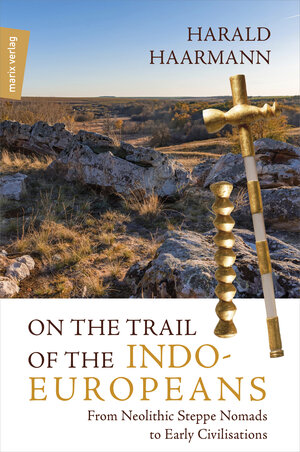On the Trail of the Indo-Europeans: From Neolithic Steppe Nomads to Early Civilisations
von Harald HaarmannInhaltsverzeichnis
ContentsIntroduction: The mystery of the Indo‑Europeans In search of linguistic affinities from a people to a race: Indo-Europeans and Aryans The swastika, an Aryan symbol?
1. Homeland in the southern Russian steppe (11th – 8th millennium BCE) Neolithic transitions: nomadic herders in the East, farmers in the West Homeland Anatolia? New findings in human genetics 28 natural environment of the steppe Indo-Europeans and Uralians: Early encounters
2. Proto‑Indo‑European language and culture (from the 7th millennium BCE) Basic structures and properties 46 names as ethnic identity markers functional variations of proto-Indo-European
3. Early steppe nomads: Social systems and worldviews (from the 7th millennium BCE) Proto-Indo-European regional cultures Early social hierarchies and patriarchal power structures Families, kinship, clans Outlines of a proto-Indo-European mythology
4. Contacts with farmers to the west (from the 5th millennium BCE) Adoption of the ‘agrarian package’ Technological innovations
5. The first migration of the steppe nomads (from the middle of the 5th millennium BCE) Migration and the motivation behind it Evidence of the nomads’ migrations Primary Indo-Europeanisation: adaptation to the elite and language shift
6. The fragmentation of Proto‑Indo‑European (from 4000 BCE) Southwards: Interactions with the Old Europeans Eastwards: Exploration of central Asia and southern Siberia The fragmentation of the common language Indo-Iranian as a macro-group The Armenians: Outlier in the Caucasus
7. Southeast Europe: The emergence of Hellenic culture (from the 3rd millennium BCE) How the Hellads became the Hellenes Under the patronage of pre-Greek deities From ritual to theatre The Hellenes and their political systems The development of the Greek language
8. Apennine Peninsula: The dominance of Latin (from the 2nd millennium BCE) Indo-Europeans in Italy The Etruscans, teachers of the romans The birth of a world language
9. The Balkans: Between Roman and Greek Civilisation (from the 2nd millennium BCE) The roman-Greek linguistic and cultural border Ancient Balkan tribal associations and kingdoms Fusion culture: Albanian
10. Central and Western Europe: Celtic and Germanic peoples (from the 2nd millennium BCE) All the way to the Atlantic coast: Celtic cultures and languages Germanic cultures, languages and nation building
11. Eastern Europe: Slavs and Balts (from the 2nd millennium BCE) The evolution of Slavic Contacts with non-Slavic peoples The splitting-off of Baltic Baltic-Finnish contacts in the Baltic Sea region: sedentary versus mobile
12. Asia Minor: Anatolian languages and cultures (from the 2nd millennium BCE) Hittites and Luwians Non-Indo-European languages and cultures in Anatolia The cult of Artemis of Ephesus Phrygian: an Indo-European outlier
13. From Central Asia to the Iranian Plateau (from the 2nd millennium BCE) The Aryan warrior caste and the Kingdom of Mitanni Early states founded by Iranian peoples Iranian languages Zoroastrianism
14. India: Dravidians and Aryans (2nd millennium BCE) Dravidian culture Aryan ‘immigration’ Cultural symbioses From Vedic to Sanskrit The Prakrits and successor languages Indic languages in southeast Asia
15. Outlying Indo‑European settlements in western China (2nd millennium BCE) The mystery of the Tarim mummies Tocharian language and culture
16. Experiments with writing: From Linear B to Ogham (1700 BCE – 500 CE) Syllabaries Alphabetic scripts
17. Epilogue: Indo‑European globalisation
Bibliography
Sources of maps and illustrations
Index










